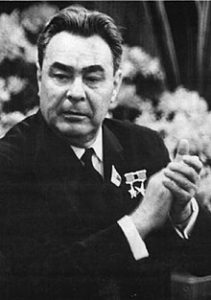
Decline of the Soviet Union
The Decline of the Soviet Union was a long, gradual process. As the International economy changed, the Soviet Union had failed to adapt. New industries and technologies were becoming central to world finances, the Soviets lagged behind in these. Soviet imports now exceeded her exports, including in the Agricultural sector. Manufacturing growth was slowing down. The USSR was no longer the second largest producer of goods, it had been overtaken by several nations. Increasing costs and a continued reliance on pre-war methods of planning had led to disillusionment. The Soviet hold over her allies was gradually weakening.

Despite reforms, the Soviet Economy had weaknesses. It had been geared to bring heavy industry in line with Europe. This was done on a grand scale in the 1930’s, through the war years and in the post-war Stalinist era. Khrushchev had reformed some parts of the economy. Consumerism was permitted to some degree. Despite Destalinisation, the economy remained centrally planned and targets aimed at specific political goals.
In the 1960’s and 1970’s the Global Economy changed. Technologies emerged that made old style heavy industry outdated. In the west, computers were being developed. Robotics was introduced onto the shopfloor. Technology was affecting most types of production, training and communication. These developments had stemmed from inventors, investors and entrepreneurs. The Soviet Union, in contrast, had planning committees dedicated to hitting targets, keeping their jobs and staying out of trouble.
Economist, Grigory Yavlinsky, summed up the outcome of the Soviet system of planning:
They pretend to pay us and we pretend to work. The Soviet system is not working because the workers are not working.
The Soviet Economy began to falter. Production levels could appear to be high but the quality was variable and the goods were often of use only within the borders of the USSR. Agriculture continued to endure bad harvests. The economy was increasingly reliant upon imports. This was possible due to the massive reserves that had been built up in the Stalin era. The USSR was buying huge amounts of food from the West. Ideologically, politically and economically this was a problem.
The Cold War had seen a large proportion of Soviet GDP (Gross Domestic Product) being spent on the military. The Nuclear Arms Race had meant a massive investment in intercontinental and medium range missiles. The period of Detente after the Cuban Missile Crisis and the SALT I and SALT II agreements offered hope that the proportion of money spent on the military could go down.
Spending on the military didn’t go down though. Nor did the amount of raw materials taken up by the military. The election of Ronald Reagan as US President meant that any hope Brezhnev had of reducing military spending was, from 1980, politically unjustifiable.
First there was a visible decline in the rate of growth, then its complete stagnation. There was a drawn-out, deepening and almost insurmountable crisis in agriculture. It was a frightening and truly terrifying sign of crisis. It was these factors that were crucial in the transition to perestroika. General Leonov, KGB
Reagan had actually noted in the build up to his election campaign that the USSR was propped up by the West. Without Western aid, it would collapse. By ensuring that the Soviets had to spend excessively on the military, he was making their survival much less likely.
The economy was at the behest of the military. The military held many important positions. Fearful of computing for the risk it posed to security, they lagged behind. Determined to match the US, they demanded, and got, the lions share of resources. The consequence was that planning was strategic in a military sense. It did little to cater for the needs of the ordinary Soviet Citizen. This led to disillusionment, poor productivity and a stagnant economy. This was an indication of the failure of reforms and a sign of the decline of the Soviet state.
A KGB Defector, Oleg Gordievsky, told the British that 30% of all Soviet goods were bound for the military. Astonished, the British sought to find out if this was true. They are reported to have concluded that, despite thinking Gordievsky was exaggerating, that the figure was actually closer to 50%. In a study after the collapse of the Soviet Union a figure of 70% was suggested. This had a bearing on the quality of life in the Soviet Union.
When Gorbachev assumed control of the state, it was in a perilous position. The economy was in decline. His reforms created the openness that made people realise that they could challenge the authorities. First in Eastern Europe, then within the Soviet Union itself.
Links
Russian and Soviet history – Fall of the Communist State – Khrushchev’s Reforms – Gorbachev
Arcane Knowledge – Essay on the Collapse of the Soviet Union.
San Jose University, Economics Dept. The Economic Collapse of the Soviet Union.
Investopedia – Why the USSR collapsed economically.
Wikipedia – the Economy of the Soviet Union.
The Atlantic – Inside the Collapsing Soviet Union.
